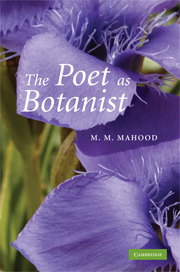Book contents
- Frontmatter
- Contents
- List of illustrations
- Acknowledgements
- A note on quotations
- Introduction
- 1 Primroses at Dove Cottage and Down House
- 2 Erasmus Darwin's feeling for the organism
- 3 Crabbe's slimy mallows and suffocated clover
- 4 John Clare: bard of the wild flowers
- 5 Ruskin's flowers of evil
- 6 D. H. Lawrence, botanist
- 7 Poetry and photosynthesis
- Index of persons
- Index of plants
7 - Poetry and photosynthesis
Published online by Cambridge University Press: 22 September 2009
- Frontmatter
- Contents
- List of illustrations
- Acknowledgements
- A note on quotations
- Introduction
- 1 Primroses at Dove Cottage and Down House
- 2 Erasmus Darwin's feeling for the organism
- 3 Crabbe's slimy mallows and suffocated clover
- 4 John Clare: bard of the wild flowers
- 5 Ruskin's flowers of evil
- 6 D. H. Lawrence, botanist
- 7 Poetry and photosynthesis
- Index of persons
- Index of plants
Summary
Any reader of poetry who lived through most of the 1900s was bound from time to time to feel that the close relationship between poetry and plant science, which had held ever since Linnaeus, was in danger of being severed. To begin with, the poets who dominated the earlier part of the century declined to write about the green world. Next, botany as the study of whole organisms began to lose its attraction for scientists and their backers. Then, in the century's closing decades, the very plants themselves began to vanish.
Fortunately, disappearance does not always imply extinction. One of England's rarest plants is called the ghost orchid, not just because it has the palest of flowers and no green parts, but also because of the spook-like way it vanishes for years from a particular spot and then re-appears 100 metres away. Cold and dry weather may discourage buds from developing, but the coral-like root can throw out long underground runners in search of better conditions and in the hope of better springs. It had not however surfaced in England for some years, and was giving cause for concern, when Michael Longley sought to conserve it in a terse lyric:
Added to its few remaining sites will be the stanza
I compose about leaves like flakes of skin, a colour
Dithering between pink and yellow, and then the root
That grows like coral among shadows and leaf-litter.
Just touching the petals bruises them into darkness.
- Type
- Chapter
- Information
- The Poet as Botanist , pp. 226 - 258Publisher: Cambridge University PressPrint publication year: 2008



